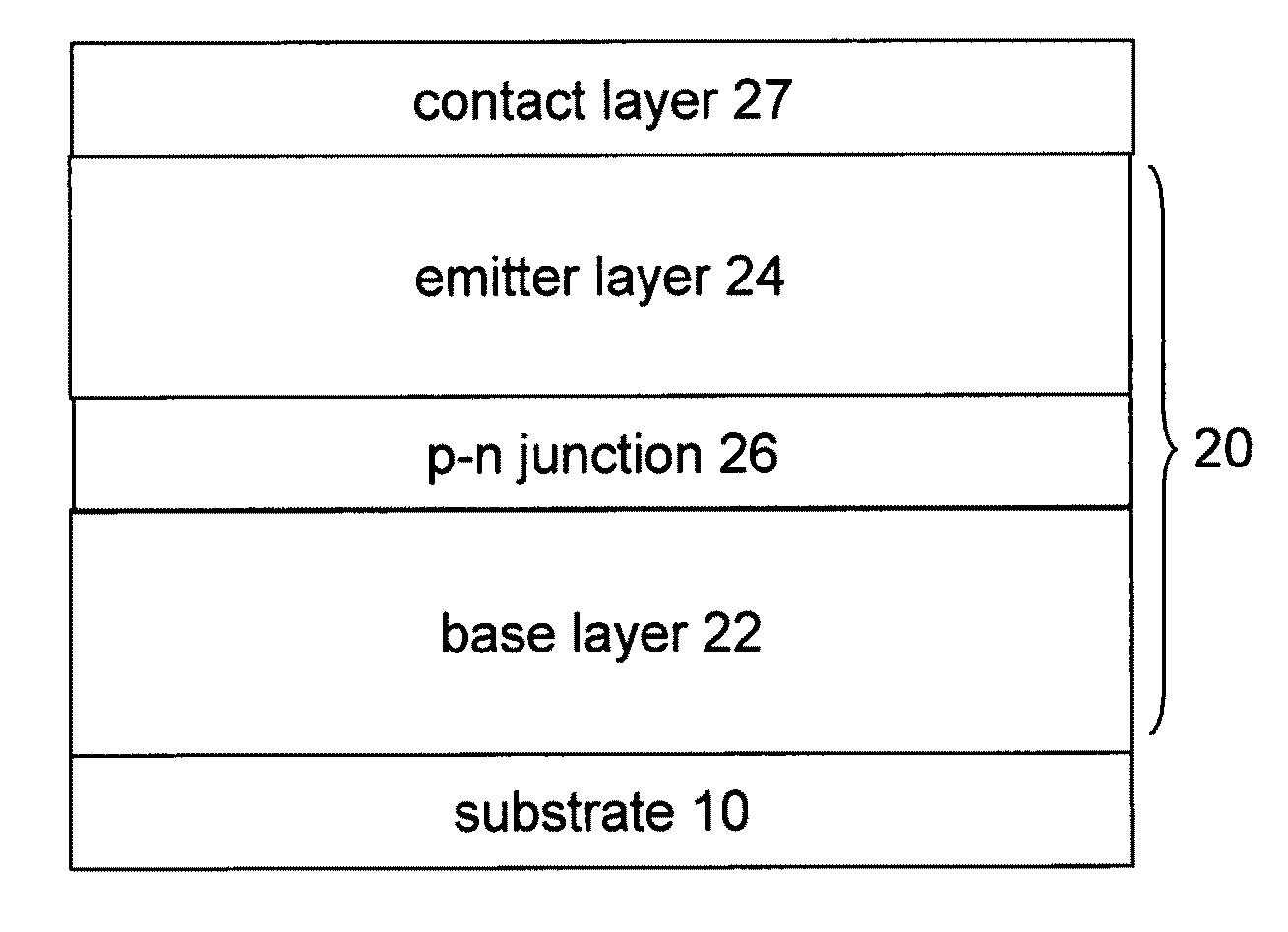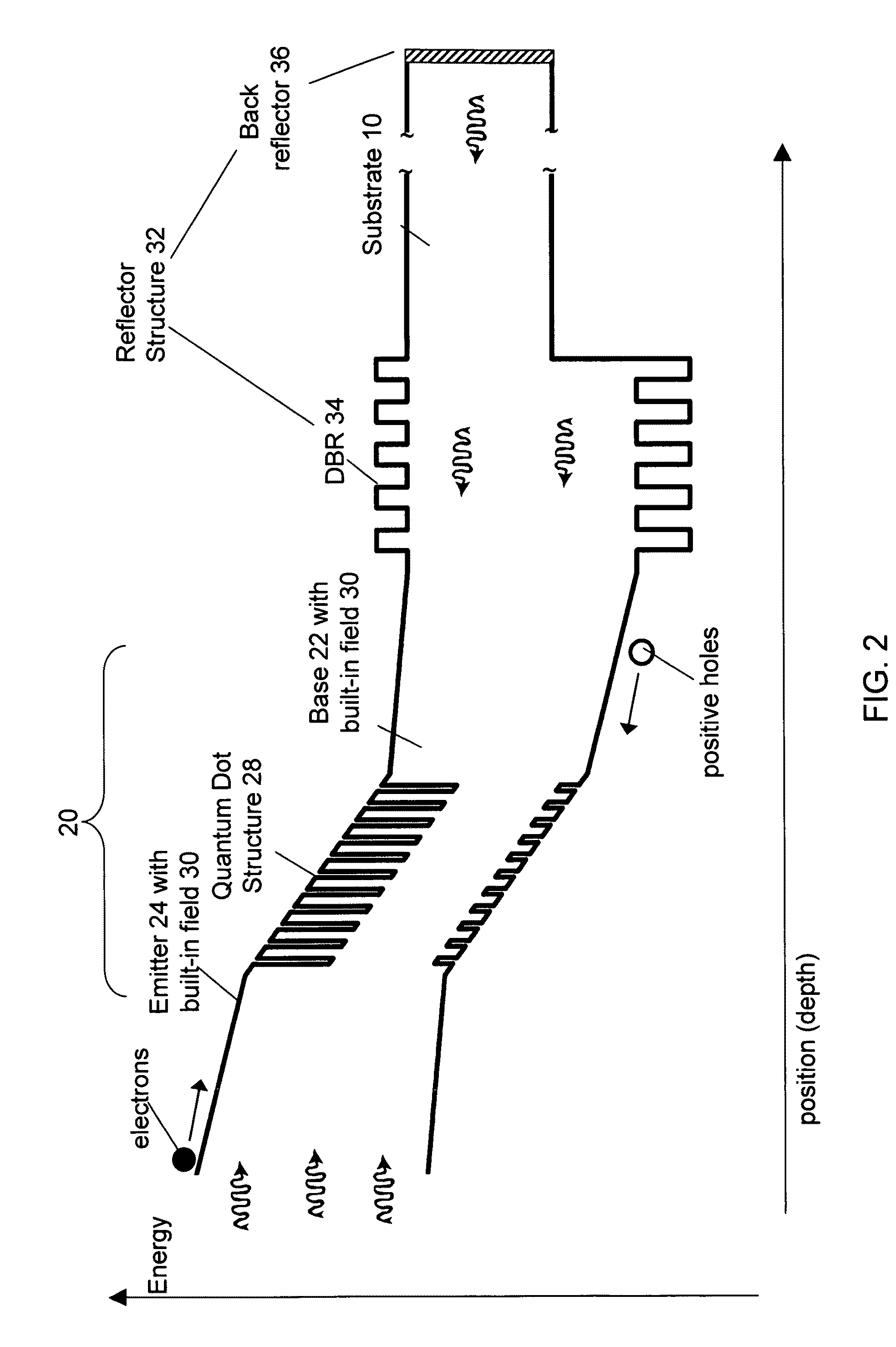Solar Cell Devices
a solar cell and cell technology, applied in the field of solar cell devices, can solve the problems of limiting the voltage of operation in the solar cell device, hampering the technical approach to high-performance solar photovoltaic devices, and limiting the conversion efficiency achieved in traditional single-junction semiconductor solar cells to less than 25%, so as to enhance the photovoltaic conversion efficiency of traditional semiconductor solar cells, enhance the performance of ingap/gaas/ge solar cells, and minimize manufacturing costs
- Summary
- Abstract
- Description
- Claims
- Application Information
AI Technical Summary
Benefits of technology
Problems solved by technology
Method used
Image
Examples
first embodiment
[0034]In a first embodiment, as shown in FIG. 2, a solar cell device of the invention further includes at least two features selected from: i) nano-structured region 28 at the p-n junction between base layer 22 and emitter layer 24 of at least one subcell, nano-structured region 28 including a plurality of quantum dots or quantum wells that are embedded within a band gap matrix that has a band gap greater than that of the quantum dots or the quantum wells embedded therein; ii) base layer 22 and / or emitter layer 24 of at least one subcell that includes either a compositional grade or a doping grade, or both, thereby having built-in quasi-electric field 30; and iii) photon reflector structure 32 between substrate 10 and p-n diode component 20, over substrate 10 and opposite p-n diode component 20, or over p-n diode component 20 and opposite substrate 10.
[0035]In a first aspect of the first embodiment, at least one subcell includes nano-structured region 28 at the p-n junction between ...
third embodiment
[0050]In yet another specific embodiment, photon reflector structure 32 includes one or more metallic layers. In yet another aspect of the third embodiment, photon reflector structure 32 includes one or more metallic layers, and is disposed over substrate 10 opposite p-n diode component 20. In these embodiments, specifically, substrate 10 includes GaP, ZnSe or ZnS.
[0051]In yet another specific embodiment, photon reflector structure 32 includes a distributed Bragg reflector (DBR) of AlAs, AlGaAs, AlGaInP, or AlInP. In yet another specific embodiment, photon reflector structure 32 includes a distributed Bragg reflector (DBR) of AlAs, AlGaAs, AlGaInP, or AlInP, and is disposed between substrate 10 and the p-n diode component 20.
[0052]In a fourth aspect of the first embodiment, nano-structured region 28, and base layer 22 that includes either a compositional grade or a doping grade, or both, thereby having built-in quasi-electric field 30, are employed. In a fifth aspect of the first em...
fourth embodiment
[0078]FIGS. 6A and 6B show one example of the FIG. 6A shows a cross-sectional view of a multi-junction solar cell of the invention. FIG. 6B shows the multi-junction solar cell of FIG. 6A in view of energy. In the device of FIGS. 6A and 6B, first subcell 50 and second subcell 52 are connected via tunnel junction 42. Alternatively, first subcell 50 and second subcell 52 can be each independently connected via a metal contact(s) (not shown in FIGS. 6A and 6B) instead of tunnel junction 42. Although only first and second subcells 50 and 52 are included in the device of FIGS. 6A and 6B, additional subcells can be added to the device of FIGS. 6A and 6B. Features, including specific features of, first and second subcells 50 and 52, and components thereof, are as described above, for example, with respect to FIGS. 2-5.
[0079]Suitable examples of materials for base layer 22 and emitter layer 26 of each of subcells 50 and 52 are as described above. Specifically, second subcell 52 includes a w...
PUM
 Login to View More
Login to View More Abstract
Description
Claims
Application Information
 Login to View More
Login to View More - R&D
- Intellectual Property
- Life Sciences
- Materials
- Tech Scout
- Unparalleled Data Quality
- Higher Quality Content
- 60% Fewer Hallucinations
Browse by: Latest US Patents, China's latest patents, Technical Efficacy Thesaurus, Application Domain, Technology Topic, Popular Technical Reports.
© 2025 PatSnap. All rights reserved.Legal|Privacy policy|Modern Slavery Act Transparency Statement|Sitemap|About US| Contact US: help@patsnap.com



